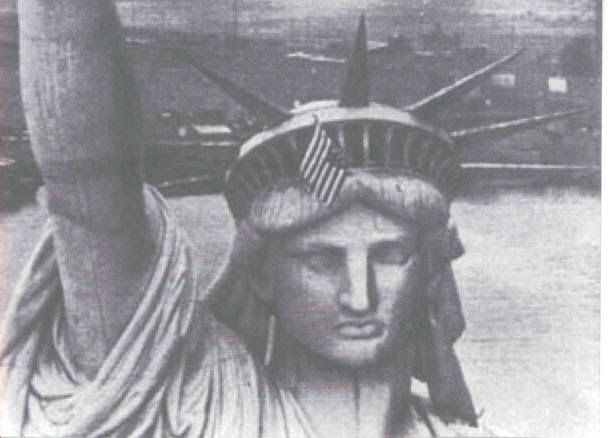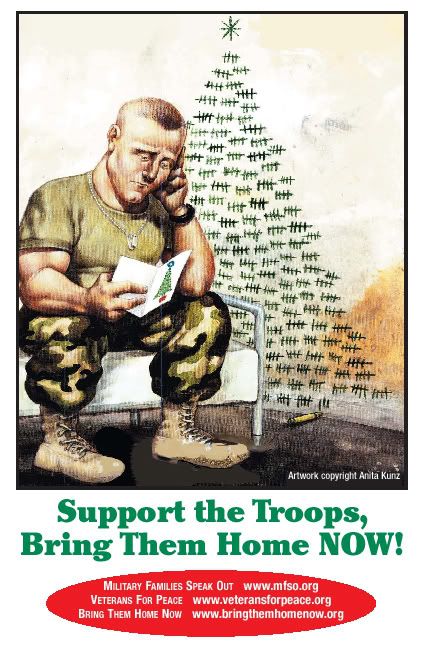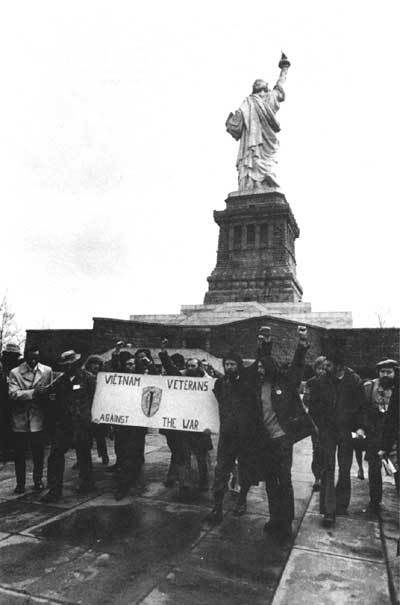A shoutout about not only our War of Choice but what our society was going through, Civil Rights Movement, care of the returning Vets, civil disobedience for the many failed policies, and more, the statement wasn't really taken seriously except by the minority, as is usually the case, the country itself just dug deeper into it's apathy and never came to terms with our War and Occupation and still hasn't!
 December 26, 1971
December 26, 1971Two dozen members of Vietnam Veterans Against the War "liberated" the Statue of Liberty with a sit-in to protest resumed U.S. aerial bombings in Vietnam. They flew an inverted U.S. flag from the crown as a signal of distress.
We've now had many years of not one but two Invasions and Occupations better known as Wars of Choice, though soldiers and those occupied are still dying in one it has become a stagnant theater on a hair trigger, the other rapidly ramping up in deaths and destruction, both are and have been recruiting actions for what we now call 'International Terrorism', Criminal Terrorism that will rear it's head, with no boundries, over and over for decades, as the number of those who will carry out these acts have greatly increased due to own terror forced on others!
Below is the '06 post with little change, to remember that shoutout of Distress on it's Anniversary, and as a call for Thought of what we now are facing. Still two occupations of others, this time those serving are doing so over and over and over.............., and to eight years of extremely failed policies and total incompetence as well as multiple corruptions and crimes, in and out of government, but also to the crimes against humanity this country has allowed and seems unwilling to face nor call accountability for!
We have the ability to change some of what is happening, even as the economy is collapsing and bringing down other economies, but we can't take back nor be forgivin for bthe deaths and destruction we've wrought on others, we can minimize the blowback, but blowback there will be, destructive and economic, for years to come!
VVAW Anniversary-Dec 26th 1971-Statue of Liberty, Liberation
Six Vietnam veterans founded the VVAW in New York City in 1967 when they marched in a peace demonstration. Organized for returning troops to voice their opposition to the war that was still taking place in Indochina, the VVAW continues to grow, with over 30,000 members, according to the VVAW web Site.
The VVAW {Vietnam Veterans Against the War} focuses mainly on achieving better benefits for all veterans.

Vietnam Veterans take the Statue of Liberty, December 26th 1971. Two dozen members of Vietnam Veterans Against the War "liberated" the Statue of Liberty with a sit-in to protest resumed U.S. aerial bombings in Vietnam.They flew an inverted U.S. flag from the crown as a signal of distress.
Peace History December 25-31 by Carl Bunin
THE STATUE OF LIBERTY: MONUMENT TO AN EXPANDING SET OF IDEALS
Tim MacCormick of New Jersey and fourteen other members of the Vietnam Veterans Against the War, on the afternoon of December 26, 1971, arrived on Liberty Island by the Circle Line boat along with other tourists. But, when the last return ship to Manhattan sailed that evening, the veterans were not aboard. Instead, just before closing time, they hid among the exhibit partitions, building materials, and storage closets which were lying about the monument's base while work was being finished on the American Museum of Immigration. When NPS personnel made their 7:30 evening check-up of the statue, they found that the veterans had seized control of the landmark and barricaded the three ground floor entrances. The men inside refused to speak to or admit any Park Service people, but on the door they posted a typewritten statement addressed to President Richard M. Nixon:Each Vietnam veteran who has barricaded himself within this international symbol of liberty has for many years rationalized his attitude to war. . . .We can no longer tolerate the war in Southeast Asia. . . .Mr. Nixon, you set the date [for leaving Vietnam], we'll evacuate. {13}
On December 27, twenty-one National Park police flew to Liberty Island from Washington where they were joined by New York City police and Coast Guardsmen. These security forces stood by while the government attempted to reach a peaceful compromise with the occupiers. They were told that they would be permitted to picket and protest on the island if they would simply vacate the statue, allowing it to reopen to visitors. The veterans rejected the offer, flew the United States flag upside down from the statue's crown, and waited. Law enforcement officers also waited. During that day thousands of disappointed tourists were told at the Battery that they could not go out to the statue. Congresswoman Bella Abzug (Democrat-New York) sent a telephone message of support to the demonstrators.
Members of the Vietnam Veterans Against the War leaving the Statue of Liberty, which they had occupied for two days. The demonstrators emerged in response to a court order, December 28, 1971.
(Source: Photograph Collection of the American Museum of Immigration, Liberty Island, U.S. Department of the Interior, NPS)
Meanwhile, United States Attorney Whitney North Seymour, Jr., went before District Court Judge Lawrence Pierce to request an injunction directing the veterans to open the doors, leave the statue except during regular visiting hours, and permit Park Service personnel and tourists to enter. On the morning of December 28 Judge Pierce issued a temporary restraining order, instructing the protestors to leave the statue "forthwith." Two hours later, after conferring with their lawyers, the veterans removed the barricades from the entrances and emerged with "clenched fists raised." They had cleaned up their debris and caused no significant damage to the property. The monument was reopened to the public, with the first ferry-load of visitors arriving at 2:15 that afternoon.
Tim MacCormick issued a statement to the press explaining why they had picked this particular target:The reason we chose the Statue of Liberty is that since we were children, the statue has been analogous in our minds with freedom and an America we love.
Then we went to fight a war in the name of freedom. We saw that freedom is a selective expression allowed only to those who are white and maintain the status quo.
Until this symbol again takes on the meaning it was intended to have, we must continue our demonstrations. . . . {14}
The Story of a Vietnam Vet
In the 1970s, when the Department of Veterans’ Affairs cut off about 7.9 million troops’ benefits, the VVAW took over the Statue of Liberty, covering her eyes with protest banners.
“This was the second time that the VVAW had taken over the Statue of Liberty. This would be an 18-hour takeover before the park police finally came and removed us,” Davis recalls. “I was one of those people inside that statue. I was the national coordinator for the (VVAW) at the time.”
There’s a glimmer in Davis’ gray-blue eyes as he tells this story.
“The New York Post carrying a front-page story about how we ruined these poor tourists’ opportunities to see the Statue of Liberty, and we weren’t very sympathetic,” he says.
Davis says that one of the things he hears the most about the VVAW is that it is simply a negative, anti-war organization, but he says that its main goals have been to provide benefits and counseling in order to help veterans.
As Davis trudges through his memories, he recalls that upon coming back, what was harder than seeing his society altered was dealing with how much he had changed.
It’s impossible for anyone who has never been in combat to understand the emotional baggage that soldiers come back with. For those who remain at home, it seems that soldiers are simply away for a while; meanwhile, the soldiers themselves are going through some of the most horrifying and gruesome experiences of their lives, and they are never the same, even when they do come back.
But men like Davis and organizations like the VVAW continue to try making life more livable for returning soldiers.
“We’ve had to do it for ourselves, and once you learn to do it for yourself, you learn to do it for other people,” Davis says. “Modern war brings a lot of horrific images. You don’t ever get over that, you just learn to deal with it.”
Stop Crying: We won our War
Disillusioned with war and plagued by nightmares back in the U.S., Romo and Davis looked to the government for psychological counseling and found nothing.
Next, they turned to the only people they knew they could trust: other war veterans.
“One of the first things we discovered pretty quickly,” said Davis,“was that if we were going to survive, we needed each other to do it.”
But interactions between the Vietnam veterans and veterans’ groups such as the Veterans of Foreign Wars and American Legion were strained, if not belligerent, Davis and Romo recalled.
“There was tremendous hostility from older veterans,” Davis said. “Many of those American Legion types and VFWs said that we were just a bunch of crybabies.”
The VVAW is Formed
But while Davis and Romo were in basic training, six Vietnam vets marched together in a 1967 New York City peace demonstration and founded Vietnam Veterans Against War (VVAW). The VVAW stood in stark contrast to the American Legion and the Veterans of Foreign Wars.
According to Davis, the America Legion represented only a small, selective group of veterans.
Davis describes the Veterans of Foreign Wars as a more egalitarian veterans’ group with the same patriotic function as the American Legion; however, neither focused on benefits. When soldiers from Vietnam began arriving home physically and psychologically damaged, Davis and Romo felt that both groups looked the other way.
From Malaise to Action
On December 26, 1971, sixteen VVAW demonstrators seized the Statue of Liberty in New York City to call attention to what Vietnam vets termed “post-Vietnam stress disorder” as well as the lack of promised programs and benefits.
“In the 1970s, because we were getting nowhere on the issue of stress disorders associated with Vietnam, we declared war on the Veterans Affairs Administration,” Davis said. “Some of us adopted the slogan that we were like ‘no deposit, no return’ bottles … Once the government had emptied us out, they chucked us.”
To assist veterans with post-Vietnam stress, the VVAW gained national recognition in the 1970s for setting up public “rap” therapy groups to help vets deal with painful memories.
We Will not be Ignored
The VVAW took over the Statue of Liberty a second time in 1976, raising even more awareness of veterans’ issues. Since that time, post-Vietnam stress disorder has been formally diagnosed and renamed by the medical community as post-traumatic stress disorder.
Now a group of over 30,000 members, the VVAW works to expose poor and under-funded care in VA hospitals, draft legislation to improve educational job programs and argue for the amnesty of war resisters and vets with questionable dishonorable discharges. During the 1980s, the VVAW publicized the Veterans’ Administration’s attempt to conceal the harmful effects of chemical defoliants like Agent Orange used during Vietnam and the Gulf War.
Passing the Torch
Davis and Romo consider themselves very lucky compared with many of their fellow veterans. Both have held steady jobs for the last 20 years and lead what they describe as normal lives with loving families.
As national coordinators for the VVAW, Davis and Romo both speak regularly at veterans’ events and meeting as well as high schools to instill the wisdom they once so desperately lacked to veterans returning today from Iraq and Afghanistan.
“We’re trying to be like mentors to the new vets,” Romo said. “Basically, we’re doing what other vets didn’t do for us.”
One Vet's Vigil
Christmas reminds Paul Fichter of Miss Liberty takeover 35 years ago
By Tim Blangger Of The Morning Call
December 24, 2006
Referance: Vietnam Veterans Against the War
The Statue of Liberty is among the best known monuments in the world. ... to take-overs by Vietnam veterans and other activists in the 1970s and 1980s. ...PDF
Vietnam Veterans Against the War
Veterans For Peace
Iraq Veterans Against the War
Iraq and Afganistan Veterans of America
Veterans for America

Military Families Speak Out
Veterans For Peace
Bring Them Home NOW
Once a soldier takes the Oath that Oath stays with him or her for life, it's engrained as are the experiances
Oath of Enlistment
I, (name), do solemnly swear (or affirm) that I will support and defend the Constitution of the United States against all enemies, foreign and domestic; that I will bear true faith and allegiance to the same; and that I will obey the orders of the President of the United States and the orders of the officers appointed over me, according to regulations and the Uniform Code of Military Justice. (So help me God.)
Oath of Office is a solemn oath taken by officers of the United States Uniformed Services on commissioning
I, [name], do solemnly swear, (or affirm,) that I will support and defend the Constitution of the United States against all enemies, foreign and domestic; that I will bear true faith and allegiance to the same; that I take this obligation freely, without any mental reservation or purpose of evasion; and that I will well and faithfully discharge the duties of the office on which I am about to enter. (So help me God.)


No comments:
Post a Comment